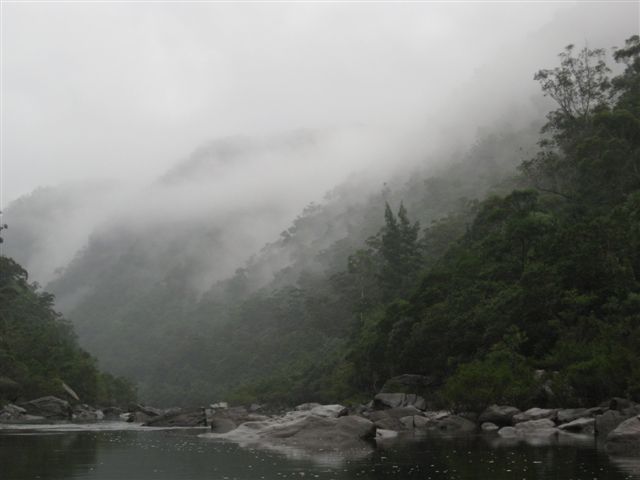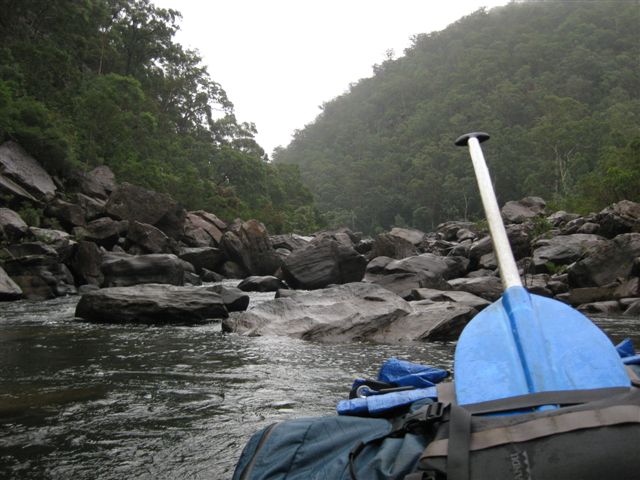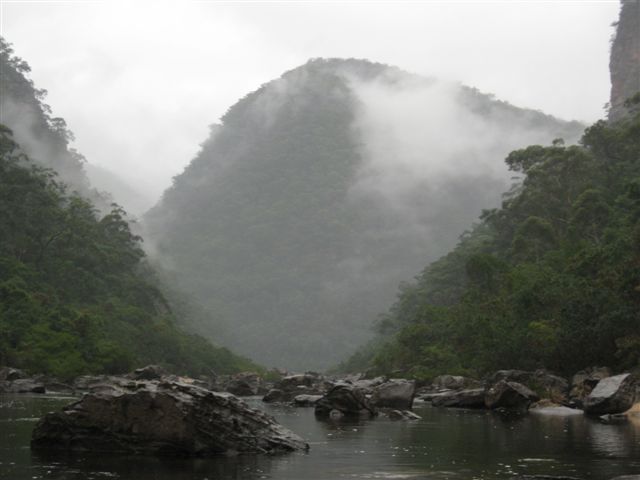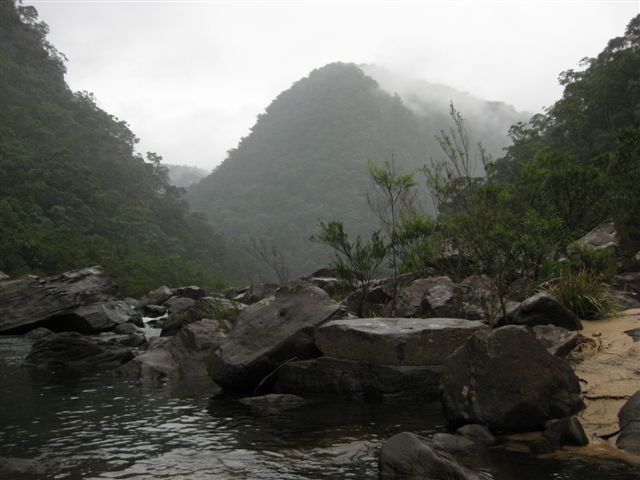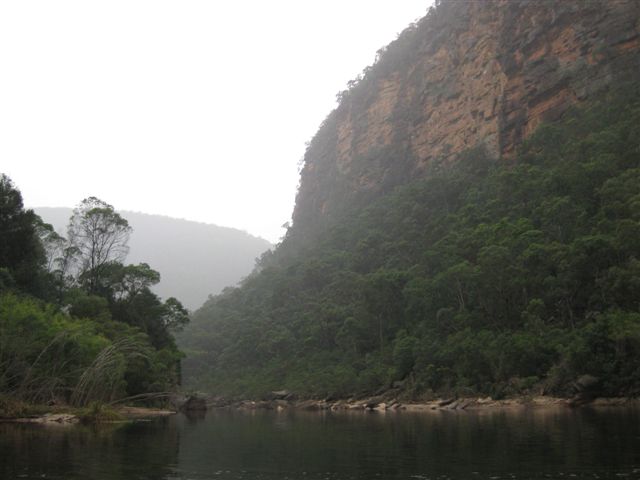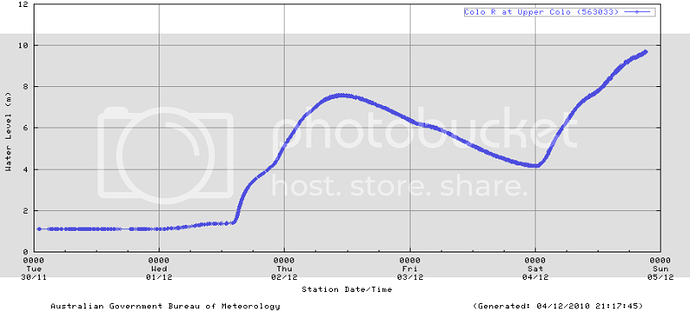ROUTE: Walk in to Colo River via Canoe Creek, paddle downstream to exit at Bob Turners Track. (Maps: Colo Heights for the first 90%, Mountain Lagoon for the last 10%)
DATE: April 23-25, 2011
CONDITIONS: BOM gauge at Upper Colo reading 0.95m on Apr 23, falling to 0.93m on Apr 25. Weather generally overcast and drizzling
DAY 1: I had the luxury of time: four days with no work or family commitments. I’d had this trip in mind for a while, and was a feeling a bit of trepidation about it – it’s a pretty remote area – but this was the ideal opportunity. After borrowing an epirb from Windsor Police Station I parked my car at the end of Grassy Hill Firetrail, off Putty Road, and got going just after 1pm – a bit later than I’d been hoping for. The walk in is steep and strenuous but not too long, about 1hr 20 mins. Colo Gorge was filled with a thin mist as Savage Ridge came into view. Started paddling at around 3pm – leaving me just over 2 hours before daylight ran out. Didn’t fancy trying the first few sets of rapids so progress was pretty slow… made about 4km before striking camp on a sandbank below some rapids. Hit the sack at about 6.30pm – first time I’d done that since I was about eight, I reckon – and fell asleep to the constant crash of whitewater.
DAY 2: Thick mist hugging the tops of the cliffs at dawn, beautiful. Got going at about 7.15am. The morning soon developed its own routine: paddling along tranquil pools, taking in the scenery and listening to the calls of Bellbirds and Eastern Whipbirds coming from the forest, then the hiss of approaching rapids. Most of these rapids I didn’t attempt to paddle; I just hopped out of the boat and kept a good hold of it as I waded along the side of the river (I was wearing a wetsuit, and walking shoes for ankle support, which was definitely a good idea for doing this). The rapids were all pretty short – about 40m at most, I reckon – and easily bypassed in this way. (With the river this low I’m not sure how many of the rapids would have been feasible to paddle, anyhow, even if I’d wanted to; you’d certainly be bottoming out a lot.) I tried to paddle a couple of the easier looking ones but even on these I was out of my depth – kept bouncing off boulders, going down backwards, getting beached on just-submerged rocks…. felt like a trailer for Laurel & Hardy Go Packrafting. I could see that the key is anticipation – putting in the paddle strokes early – but even when I tried doing this I had the uncanny knack of hitting the very obstacles I was trying to avoid, as if I were drawn to them by some invisible force. Never mind… I didn’t want a white-knuckle ride anyway, I just wanted to experience the Colo Gorge.
And I wasn’t disappointed. This place is incredible. As the morning went on the cliffs on either side grew bigger and more impressive. With its towering red sandstone walls and thick forest it looks more like something out of the Northern Territory than a couple of hours outside of Sydney. (Unfortunately my camera started playing up, giving me Memory Card Error prompts, and the only way I could clear it was formatting the memory card that night….so the only photos I’ve got, below, were taken from the Wollangambe Junction onwards. A bit of a bugger)
I stopped for a late breakfast below the rapids at Main Creek, then reached the Wollangambe at 2pm. I had intended to push on further before striking camp but as soon as I saw this spot I thought, this’ll do me. (Found a nice flat spot for my tent next to a giant boulder into which someone had hacked “Wallangmbe 1943”. I know you shouldn’t judge previous generations by the standards of today, but really, what a vandal, and an illiterate twat to boot). Opposite were mighty cliffs, 200m high, catching the rays of the afternoon soon which was just breaking through the clouds for the first time on this trip. The Wollangambe looks like a lovely river; little fish were sitting in its inflow, sending out concentric ripples as they sipped food off the surface. I went out with my rod and a surface lure to try to tempt their bigger brothers; no luck though. At dusk the big cliffs opposite caught the last of the sun, turning deep red. Hit the sack at 7.15pm – thought I’d have a late one.
DAY 3: Grey, overcast morning. Packing up gear that’s wet from condensation on a sandy campsite not much fun. Got going at 7.30am. At the first set of rapids below the big pool at the Wollangambe junction I really noticed the extra volume of water, and its power. Picked my way carefully through the boulders, dragging my boat over them where necessary (it had picked up only a few scuffs on the bottom by the end of this trip, amazing really considering the amount of dragging and bouncing over rocks it did). I had a go at paddling the next rapids, and as I spilled out at the end I saw that my clumsy efforts had been witnessed by a solitary bloke on the riverbank. I paddled over to say hi. Nick had hiked in via the Drip Rock Firetrail and taken a pass which dropped him about a kilometre north of the Wollangambe junction (he was using the Anthony Dunk book, and described the route as “pretty sketchy”). After a good chat I pushed on. It was drizzling with rain and a thin mist was hugging the forest high above the riverbank – a beautiful sight. After about 3.5km I reached a long, long pool, at the end of which was a short but very steep set of rapids filled with giant boulders; I think this was the “King Rapids”. The boulders here were super slippy and I took a nasty fall while portaging; nothing broken thankfully. Then there were another few sets of rapids below this to overcome… by this time I was getting pretty exhausted by all the carrying and dragging. Then a long, final pool brought me to the exit point at the Bob Turners Track at about 1.20pm. As I was packing up a rescue helicopter appeared and flew up the gorge, before returning ten minutes later and going towards Colo Heights… hope they were alright.
I underestimated the amount of time it would take me to reach my car from here…I hadn’t counted on feeling quite so shagged at this stage! The climb-out along the Bob Turners Track was about an hour, then I picked up my bike – which I’d stashed in the bushes at the end of the firetrail – and cycled the 28km back to my car at the end of the Grassy Hill Firetrail. That took me about three hours; I was ready to drop by the time I reached the car.
A terrific little adventure in an amazing part of the world. Thanks for all the advice people have put on this forum, it stood me in good stead. Some pics here of the Wollangambe junction, and downstream, from the morning of day 3.
